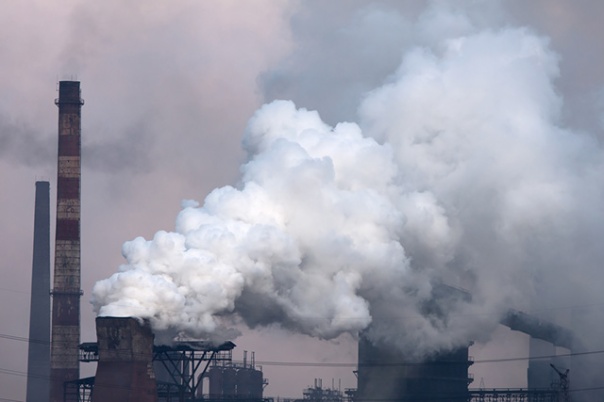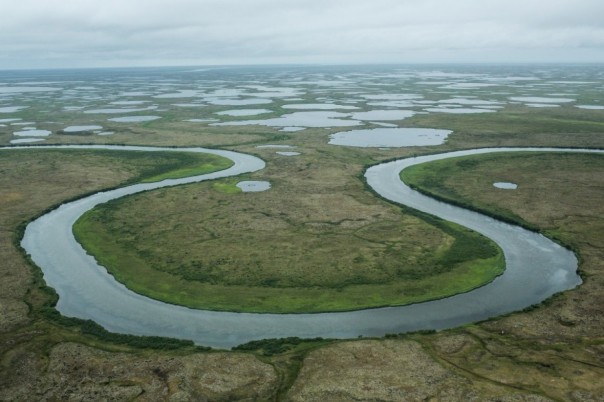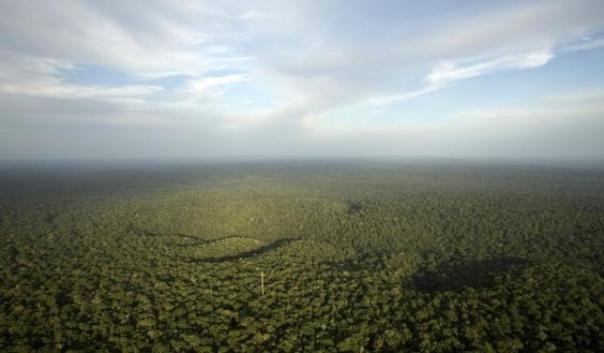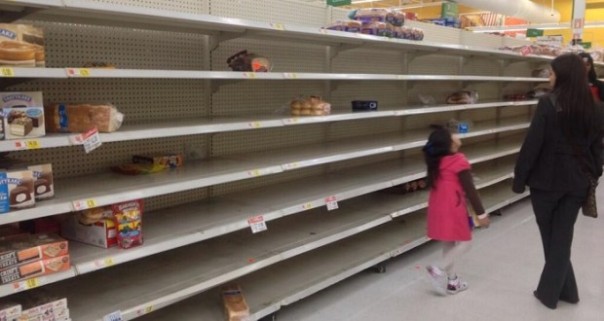
Oldspeak: “While infotainment streams that pass for news media are feeding us proles wall to wall coverage of the Kabuki Theater passing for U.S. elections, the ecology upon which all life depends, continues to deteriorate at an ever accelerating pace. Dahr Jamail is back with his latest monthly postcard from the edge. 4 billion people are facing water scarcity. That reality will only get worse as temperatures rise. Seas are acidifying and rising faster than expected swallowing coastlines, polar ice is vanishing ever faster, soil productivity is decreasing, droughts expanding, the ranks of climate refuges continue to swell, oh, and there is a giant 1,400 mile swath of wildfire raging in Africa. Relentlessly and irresistibly, Earth’s 6th and fastest proceeding mass extinction rumbles along and there’s nothing we can do to stop it. Buckle up kids, it’s gonna be a bumpy ride!” -OSJ
Written By Dahr Jamail @ Truthout:
Recently, a Norwegian Coast Guard icebreaker ship took an interesting trip into the Arctic. The ship found no ice to break, despite the fact that it was the dead of winter and barely 800 miles from the North Pole.
Indeed, record-low levels of Arctic sea ice are becoming normal. The ice is disappearing before our very eyes.
Satellite data now shows we are witnessing a very rapid acceleration in global sea level rise. In the last six years, oceans have risen by five millimeters per year, which is a rate not seen since the ending of the last Ice Age – and it is accelerating.
One of the most alarming indicators of ever-accelerating anthropogenic climate disruption (ACD) this writer has witnessed since beginning these dispatches is the fact that atmospheric carbon dioxide, in early February, reached a level not seen on the planet in the last 15 million years.
This year is already on pace to be hotter than the previous hottest year ever recorded, which was 2015.
Thanks to humans, the earth was (since the 1990s) already experiencing atmospheric carbon dioxide levels in a realm not experienced on the planet since the Pliocene epoch, which was the period 2.6 to 5.3 million years ago that saw atmospheric carbon dioxide levels between 350 and 405 parts per million and average global temperatures that ranged between 2 and 3 degrees Celsius warmer than the climate of the 1880s.
Now we must brace ourselves for a new world, as carbon dioxide levels exceed even that epoch – a time when global sea levels were 80 feet higher than they are today.
Reaching 405.66 parts per million has brought us into another epoch – the epoch of the Anthropocene, as ACD impacts are becoming more apparent by the day.
This year is already on pace to be hotter than the previous hottest year ever recorded, which was 2015. NASA recently reported that January 2016 was by far the hottest January on record. January 2016 blew out the previous record for hottest January (2007) by nearly 0.3 degrees Fahrenheit.
Also in January, the Arctic averaged a stunning 13.5 degrees Fahrenheit above average temperatures, which led to a new record low of Arctic sea ice extent for the month.
NASA data shows that the previous 12 months have also been the hottest 12-month period every recorded, using the space agency’s 12-month moving average.
It cannot be overstated how shockingly dramatic the changes impacting the Arctic are this winter. We should all be highly alarmed by the fact that throughout the Arctic above 70 degrees north latitude, January temperatures averaged between 7 and 23 degrees Fahrenheit hotter than usual for, most incredibly, the entire month.
What we are witnessing there is unprecedented, as the January average temperatures in the area of the Arctic above 80 degrees north latitude were the same as they usually are for April. Literally, the further north you go, the warmer it becomes.
Keep these stunning changes in the Arctic in mind, as this month’s global survey of abrupt climate disruption continues.
Earth
Evidence of ACD progressing more rapidly than ever continues to abound when we inspect what is happening on the ground.
This past December and January were filled with firsts across the United Kingdom. December 2015 proved to be both the warmest and wettest ever recorded, followed abruptly by a day that saw more than 600 species of flowers in bloom, whereas a normal (pre-ACD year) would have seen between 30 and 40 species in bloom.
Recent research published in Royal Society Open Science provided some even more disturbing news: The increasingly warm temperatures associated with ACD are causing some eggs to hatch earlier than others. In other words, ACD is removing birds’ control over when their eggs hatch.
The news is equally dismal for the beautiful snowshoe hare. A study published in Ecology Letters in January shows that animals like this particular hare, which have camouflage that changes to match the seasons, will now be much more vulnerable to their predators, thanks to later arriving winter snows and earlier spring melting.
Upwards of 20 million people in Bangladesh will likely lose their homes by 2050 due to increasingly severe storms, sea level rise and erosion.
Up in Alaska, it’s so hot now that the traditional hunt for bearded seal last summer was cut abnormally short due to melted ice, causing the Native community there to worry about losing the ability to continue with their traditional ways of acquiring food and practicing their culture. Normally, the hunt lasts an average of three weeks; this year, it lasted less than a week.
A recently released report shows that the Yukon, like the Arctic, is already experiencing dramatic ACD impacts. The Yukon’s temperature is rising twice as fast as it is elsewhere around the planet, according to the report, and the region has already lost at least 22 percent of its glacial cover.
ACD’s impacts continue to mount in the Antarctic as well. A recent study shows a “major decline” of penguins in the Antarctic. One colony will likely disappear altogether within 20 years, due to increasingly large icebergs (due to rapid warming of the ice shelf causing them to calve) cutting off penguins’ access to the sea where they feed.
ACD is also impacting soil productivity in agriculture, which is in turn making societies more vulnerable, according to a recent report. Consistent degradation of soils means that hundreds of millions of people around the globe will likely become displaced due to the lack of an ability to grow food in the coming decades.
A recent report on Bangladesh reveals that upwards of 20 million people there will likely lose their homes by 2050 due to various aspects of ACD, including increasingly severe storms, sea level rise and erosion.
Emergency response organizations, including the United States’ Federal Emergency Management Agency (FEMA), are now using climate data in order to better prepare themselves to deal with weather-related disasters, which are becoming far more frequent and severe.
The US Southwest, already by far the hottest and most arid region of the country, is set to enter what experts are diplomatically calling a “drier climate state.” A recent study shows that rains and mountain snows are drying up, and many experts already believe the region has entered a multidecade megadrought.
Similarly, another report shows how experts are scrambling to figure out what is causing the tropics, and dry zones next to them, to expand rapidly toward the poles. While the heart of the tropics is lush, the northern and southern edges are quite dry, and those parched borders are now rapidly growing both to the north and south.
Water
Speaking of droughts, in Zimbabwe, drought has become so intense that the country is asking for an additional $1.6 billion in aid to help buy grains and other food to help more than 3 million people already in desperate need. The drought there is bad enough that the country’s president, Robert Mugabe, recently declared a state of emergency.
A recent study assessed the likelihood that “dust bowl” conditions will emerge in the United States in the 21st century, and found that a dust bowl similar to that of the 1930s would have just as intense an impact on agriculture – but that the next one might be even larger.
A recent analysis in the journal Science Advances shows that global water scarcity is a far, far greater problem than many had previously thought: It is already affecting 4 billion people – two-thirds of the world’s population – and will be “one of the most difficult and important challenges of this century,” as the water table “all over the world” continues to drop, according to the recent study.
Meanwhile, up in the Arctic, distressing new information from the US National Snow and Ice Data Center in Boulder, Colorado, shows that Arctic sea ice extent has settled to its fourth-lowest level ever measured at the end of the most recent melt season. In January, the ice extent hit a new record-low average for the month. Then, in the beginning days of February, the Arctic sea ice extent and area both broke records again, as the entire global sea ice area entered the second-lowest range ever to have been recorded.
Ocean acidification (fueled by ACD) is expected to cause skeletal deformities in half of global juvenile corals.
The shrinking of the ice is having immediate and severe impacts on wildlife: A recent study shows that polar bears in Alaska, due to shrinking and faster-moving ice, are having to work harder in order to continue to live in the northern regions of that state, where they prefer to hunt. This means the bears now must catch and eat as many as four additional seals every year in order to maintain the caloric content they need to overcome the distances they must travel.
Down in the Antarctic, a recent study warns that glaciers there are increasingly vulnerable to quickening melting as water temperatures in the Southern Ocean continue to warm.
In the northeastern Pacific Ocean during 2014, millions of starfish up and down the West Coast, from Mexico all the way to Alaska, died off. That strange occurrence was recently linked to warming ocean waters. In the northeastern Pacific, waters have reached their warmest temperatures in decades – a trend driven by ACD, according to recent findings.
More distressing news about the decline of life in the oceans came in with another report, which shows that ocean acidification (fueled by ACD) is expected to cause skeletal deformities in half of global juvenile corals, making them increasingly susceptible to dying off.
Also on the ocean front, a recent study published in the Proceedings of the National Academy of Sciences shows that warming oceans are actually making coastal flooding worse. According to the study, this is because of the expansion of warming waters, which caused as much sea level rise from 2002 through 2014 as the melting of all the glaciers and the Greenland and Antarctic ice sheets combined.
Hence, another report revealed how the US East Coast is now considered to be a “hot spot” for rising seas driven by ACD. This is due to several ACD-linked factors, including warming water (which expands as it warms), more severe storms and a stronger Atlantic meridional overturning circulation, on which Truthout previously reported in detail.
Some interesting ramifications of these ACD impacts driving water shortages are already playing out in North Carolina, where population growth, industrial development, sea level rise and other factors are already threatening the availability of freshwater, and have kicked up competition for water rights.
The East Coast isn’t the only part of the United States that is facing freshwater availability issues. A recent report from Climate Central shows that there will be an increase in the continuing trend of more rain and less snow during US winters, which will impact the Pacific Northwest, California and other parts of the United States as well.
We recently saw the occurrence of the first ACD refugees in the United States, when Native Americans living in the marsh of Louisiana were awarded $48 million from the federal government in order to relocate off of their disappearing land, which is being swallowed by rising seas.
Lastly in this section, the impact of the ongoing drought in California continues in the state’s driest county, Tulare, where there continues to be no running water – and no solutions.
Fire
A massive outbreak of major wildfires across western and central Africa ignited recently. Spanning a half-dozen countries, the 1,400-mile-long swath of fire is visible from space. It has created an apocalyptic scene across a region of Africa that was already beset with record-breaking drought and staggering levels of hunger.
It is worth noting that wildfire incidences like this one, which are occurring across the globe now more frequently, with greater severity, and causing more damage than ever, also function as yet another feedback loop in regard to ACD: As the planet warms, arid regions dry further, causing more wildfires, which warm the planet further, and so the cycle amplifies itself.
Air
Scientists now believe that the massive blizzard that struck the US East Coast was fueled by ACD. Higher-than-normal Atlantic surface waters off the East Coast acted to fuel the storm, and hence, larger-than-ever East Coast snowstorms are now becoming the norm.
Hotter air and water temperatures in and over the Pacific caused the most powerful cyclone ever recorded, with sustained winds hitting 200 miles per hour. The cyclone hit Fiji and killed at least 19 people.
Meanwhile, as air and water temperatures around the globe continue to warm, health experts have warned that diseases like the mosquito-borne Zika virus may well become worse and more prevalent across the planet.
A record-setting heat wave in California saw stunningly warm temperatures for the middle of February. Up and down the coast of that state, record high temperatures were seen, including 89 degrees Fahrenheit in Los Angeles, 94 in Orange County and 77 in San Francisco.
Lastly in this section, a recent study shows how ACD is making westbound transatlantic flights significantly longer. Climate disruption is strengthening high altitude winds by speeding up the jet stream, as it has long since been expected to do.
Denial and Reality
There is never a dull month in the ACD-denial section, particularly when one lives in the United States.
In late January, a group of US states, led by oil-producing Texas and coal-producing West Virginia, asked the Supreme Court to put a hold on President Obama’s aims to curb carbon dioxide emissions from power plants in order to mitigate ACD.
A 1982 report by the American Petroleum Institute shows that, even then, the group knew of ACD’s impacts. Their report states that ACD “can have serious consequences for man’s comfort and survival.”
The Heartland Institute, a think tank funded by the fossil fuel industry and infamous for backing ACD denial, recently distributed a non-science-based report denying the scientific consensus on ACD to elected officials.
Still, the proponents of a reality-based approach to climate disruption are always growing. A recent poll shows that the vast majority of Americans back government action aimed at mitigating the impacts of ACD.
Decisions around mitigation measures will have long-ranging effects: A recently published study in Nature Climate Change looks into the “deep time” implications of carbon dioxide impacts and found that government policies today that are being set to mitigate (or not) carbon dioxide impacts will have implications spanning at least the next 10,000 years.
Meanwhile, the so-called Doomsday Clock, a symbolic countdown to global catastrophe that is maintained by the Bulletin of the Atomic Scientists, remains unchanged at three minutes until midnight. The clock’s hands “are the closest they’ve been to catastrophe since the early days of above-ground hydrogen bomb testing” in the 1950s, largely due to the ongoing threats to the planet from ACD.






 Oldspeak : “Climate experts have long predicted severe consequences for global food security if serious steps are not taken to mitigate climate change. Rising temperatures, more frequent droughts and more severe weather events are expected to cause agriculture in certain areas to suffer, all while the global population — and its demand for food — continues to skyrocket.
Oldspeak : “Climate experts have long predicted severe consequences for global food security if serious steps are not taken to mitigate climate change. Rising temperatures, more frequent droughts and more severe weather events are expected to cause agriculture in certain areas to suffer, all while the global population — and its demand for food — continues to skyrocket.